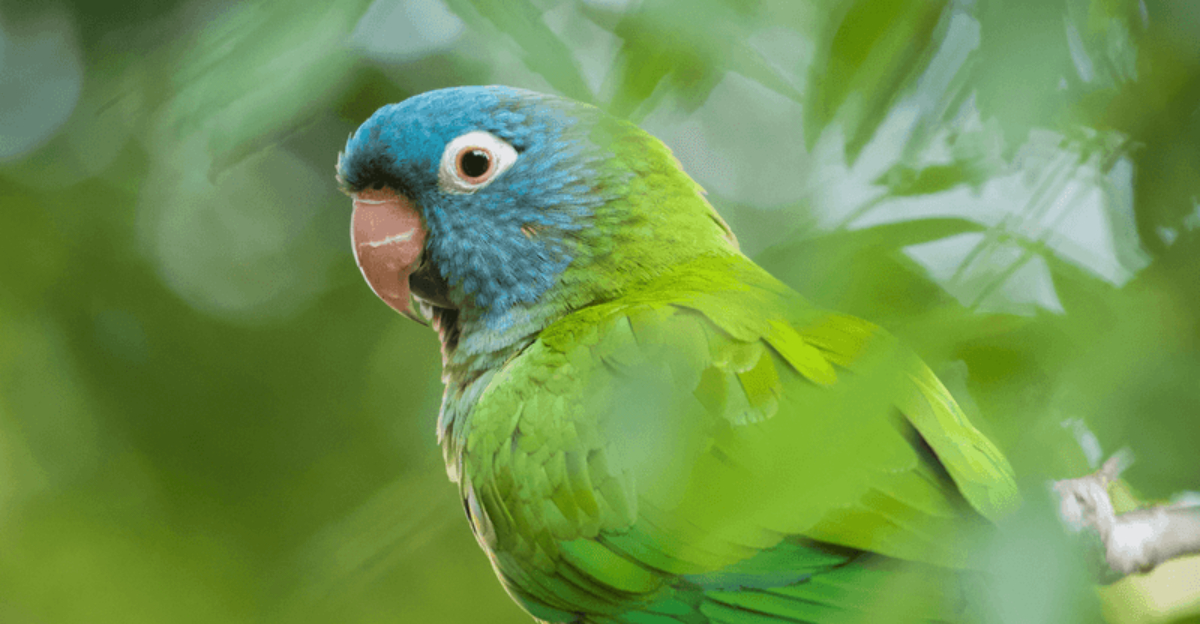California’s skyline is iconic, not only for its stunning sunsets and iconic palm trees but also for the surprising presence of a wide variety of parrot species.
Though these vibrant birds aren’t native to the state, they’ve successfully established thriving populations after being released or escaping from captivity.
Over the years, I’ve spent many hours observing these remarkable creatures, binoculars in hand, as they soar through both urban landscapes and serene parks. The sight of them is nothing short of breathtaking. Let me share with you the fascinating story of the colorful parrots that have made California their home.
1. Red-crowned Amazon (Amazona viridigenalis)
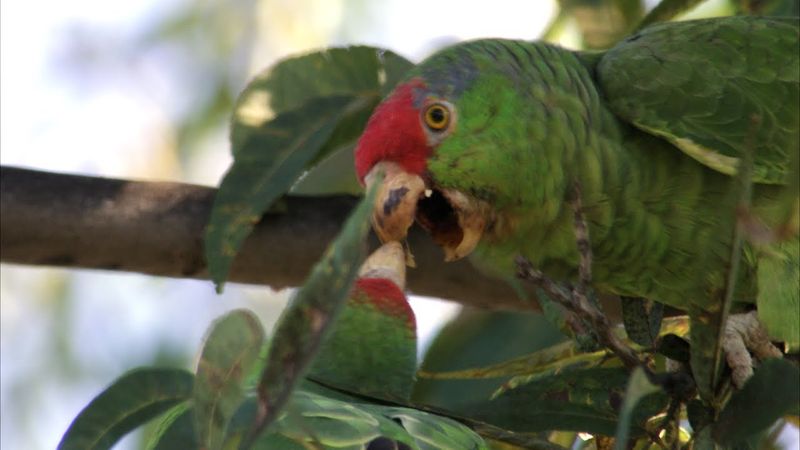
Squawking loudly overhead in San Francisco, these emerald-feathered charmers with their distinctive red foreheads always make me smile! The first time I spotted a flock, I nearly dropped my morning coffee in excitement.
Red-crowned Amazons typically gather in noisy groups at dawn and dusk, creating quite the neighborhood alarm clock. Their population has actually grown in California while declining in their native Mexico.
These intelligent birds can live up to 60 years and form strong pair bonds. You’ll often spot them munching on fruits in urban parks or nesting in palm trees throughout coastal California communities.
2. Lilac-crowned Amazon (Amazona finschi)

My heart skips a beat whenever I glimpse the subtle lavender crown of these gorgeous parrots in San Diego’s urban jungle. Unlike their louder cousins, Lilac-crowned Amazons have a gentler, almost musical call that carries through neighborhood canyons.
These medium-sized parrots sport a magnificent green plumage complemented by that signature lilac crown and a splash of red on their wing edges. They’re particularly fond of eucalyptus trees for roosting.
A threatened species in their Mexican homeland, these feathered immigrants have found sanctuary in our Southern California communities, where they feast on seeds, nuts, and fruits from local gardens.
3. Blue-crowned Parakeet (Thectocercus acuticaudatus)
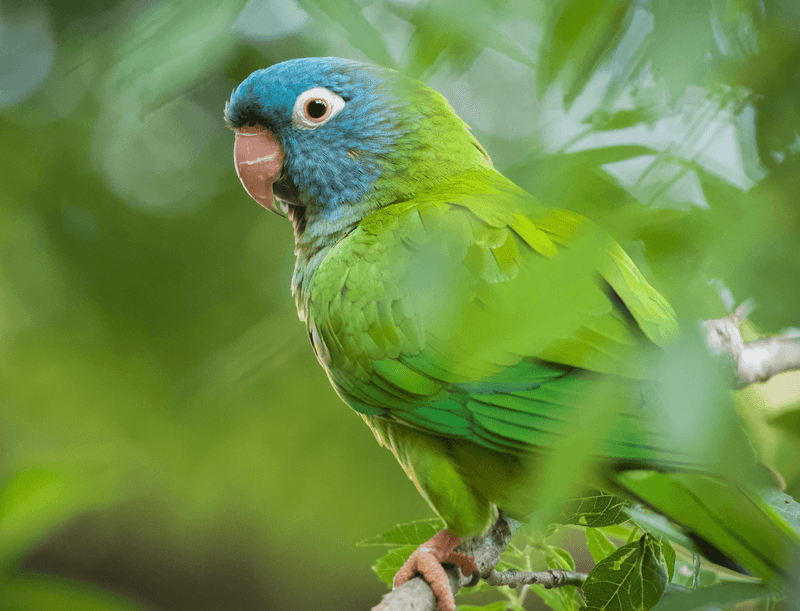
Zipping through the air like feathered rockets, Blue-crowned Parakeets bring a touch of tropical flair to California’s urban landscapes. The first time I spotted their acrobatic flight patterns while picnicking in Pasadena, my sandwich was completely forgotten!
These medium-sized parakeets showcase a gorgeous blue crown atop their predominantly green bodies. Their long, pointed tails help them navigate through tight spaces with impressive agility.
Originally from South America, these social butterflies have established small colonies in Southern California. They’re particularly fond of palm seeds and can often be spotted in small, chattering groups exploring fruiting trees and flowering plants.
4. Mitred Parakeet (Psittacara mitratus)
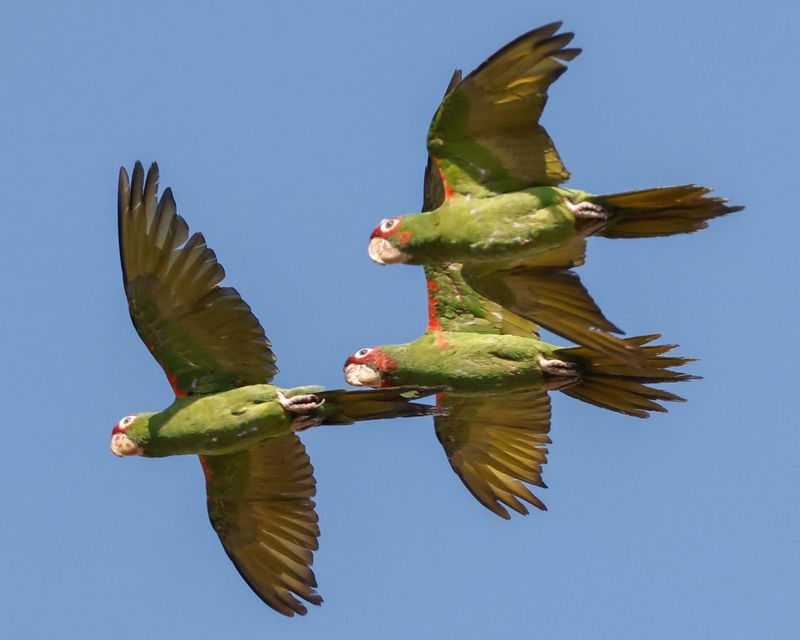
Sporting flashy red masks that remind me of superhero disguises, Mitred Parakeets always brighten my weekend hikes through Los Angeles parks. Their raucous calls announced their presence long before I spotted them darting between jacaranda trees.
These social creatures travel in tight-knit flocks, creating green and red blurs across the sky as they zoom to their next dining destination. Native to Peru and Bolivia, they’ve adapted surprisingly well to California’s Mediterranean climate.
Mitred Parakeets are particularly fond of suburban areas with plenty of trees. Their impressive climbing skills and strong beaks make quick work of nuts and seeds, while their intelligence helps them thrive in these new surroundings.
5. Rose-ringed Parakeet (Psittacula krameri)
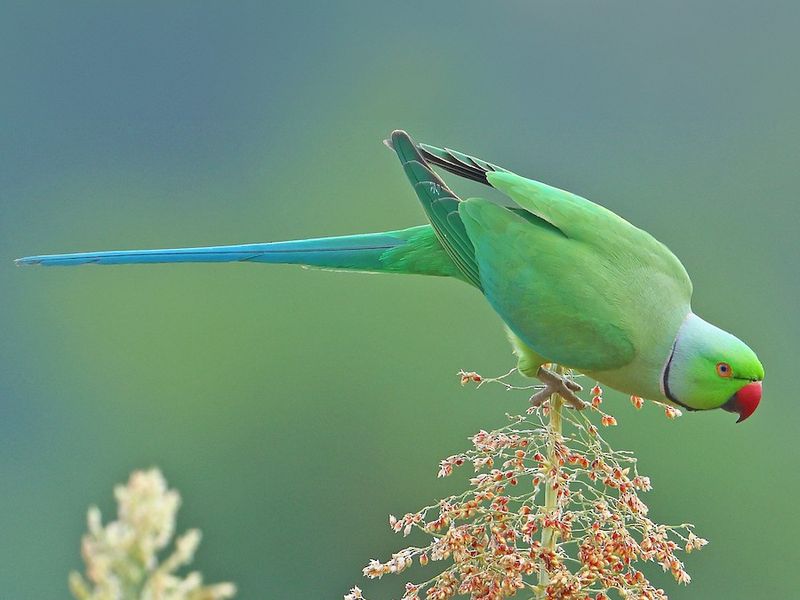
Elegant and slender, Rose-ringed Parakeets bring a touch of exotic grace to California’s urban landscape. I’ll never forget spotting my first one – its emerald plumage practically glowing against a Bakersfield sunset as it perched on a telephone wire.
The males sport a distinctive rose-colored ring around their necks (hence the name), while females maintain a uniformly green appearance. Their long tail feathers create a striking silhouette against the sky during flight.
Originally from Africa and India, these adaptable birds have established several colonies throughout California. They’re particularly fond of fruit trees and can sometimes be spotted raiding backyard gardens with remarkable problem-solving skills.
6. Nanday Parakeet (Aratinga nenday)
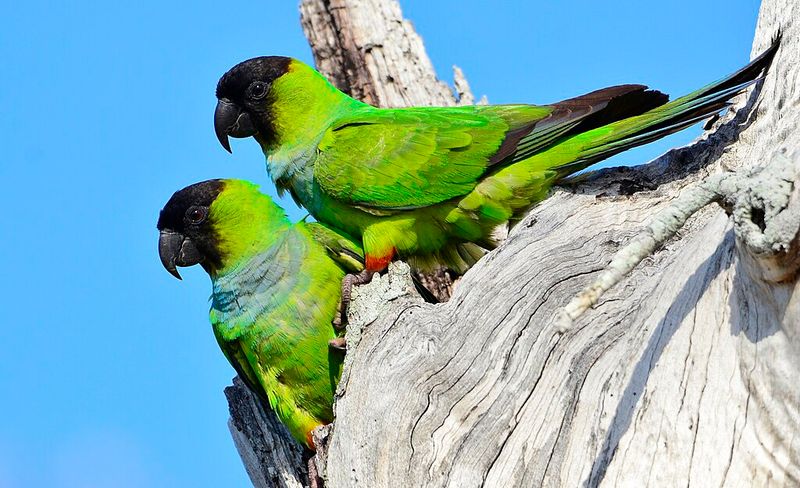
Sporting a dramatic black face mask that makes them look like avian bandits, Nanday Parakeets always crack me up when I spot them in Southern California parks. Their playful antics and acrobatic flying skills once had me laughing so hard I nearly dropped my camera!
These medium-sized parakeets combine emerald green bodies with that distinctive black facial area and blue-tinted wing feathers. They’re incredibly social, forming tight-knit flocks that communicate with sharp, piercing calls.
Originally from South America, Nandays have established themselves primarily in the Los Angeles basin. They’re particularly fond of palm fruits and seeds, often hanging upside-down to reach the tastiest morsels with their strong, curved beaks.
7. Blue-fronted Amazon (Amazona aestiva)
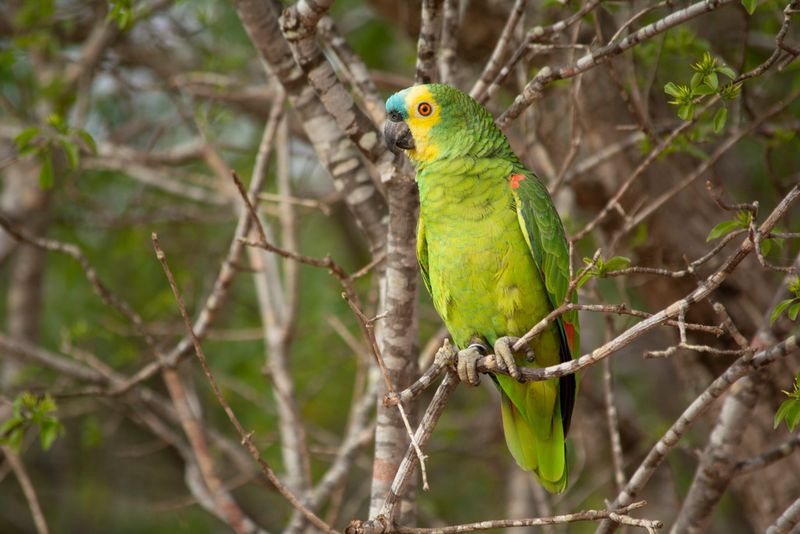
With personalities bigger than their already substantial bodies, Blue-fronted Amazons have charmed their way into California’s urban landscape. During my morning jog through San Diego’s Balboa Park, one of these chatty characters whistled at me from a eucalyptus tree!
These striking parrots feature a blue forehead (sometimes yellow-tinted), yellow face, and primarily green body. Their remarkable ability to mimic human speech makes them popular pets – which explains how they initially found their way into California’s wild parrot population.
Though less numerous than some other parrot species in the state, Blue-fronted Amazons have established small colonies in coastal areas. They’re particularly fond of seeds, nuts, and fruits found in parks and gardens.
8. Red-masked Parakeet (Psittacara erythrogenys)
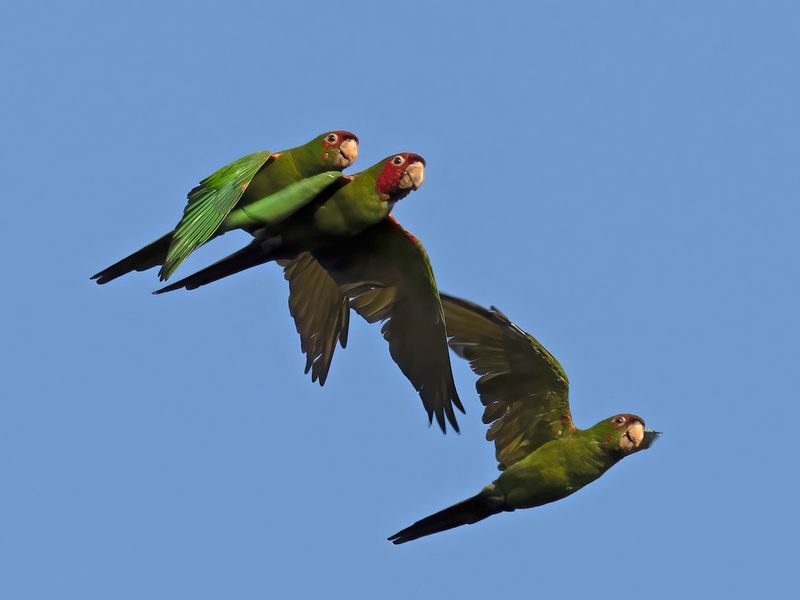
Fiery personalities matched only by their blazing red facial masks, Red-masked Parakeets bring tropical drama to California skies. I nearly spilled my lemonade the first time a flock zoomed overhead during my backyard barbecue in San Francisco!
These medium-sized parakeets combine lime-green bodies with vibrant red faces and wing patches. They’re incredibly vocal, exchanging constant contact calls that sound like high-pitched chatter as they fly in tight formation.
Native to Ecuador and Peru, these adaptable birds have established thriving colonies along coastal California. They particularly love fruit trees and flowering plants, making suburban gardens and parks their preferred dining spots.
9. White-fronted Amazon (Amazona albifrons)
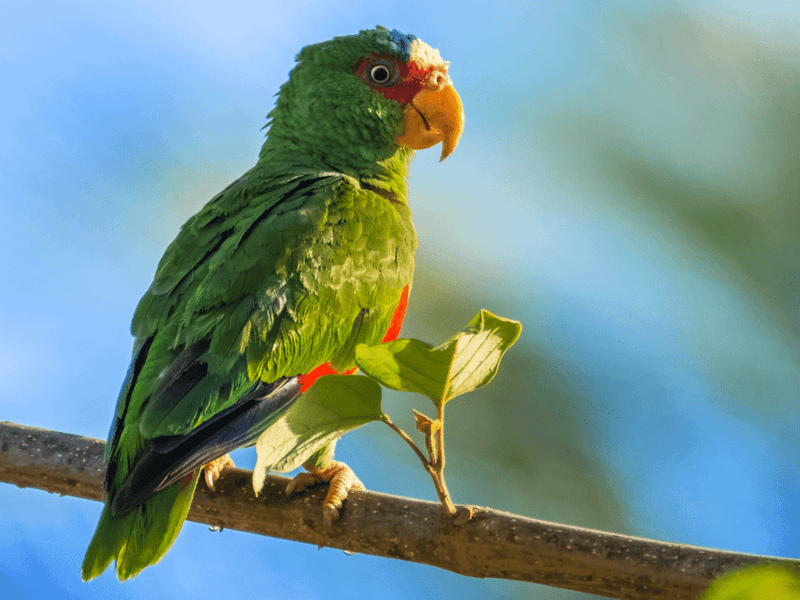
Personality packed into a pint-sized package! White-fronted Amazons may be smaller than their Amazon cousins, but their antics always leave me in stitches. One particularly cheeky fellow once followed me through a Long Beach park, mimicking my whistle with impressive accuracy.
These compact parrots sport a distinctive white forehead (hence the name), red wing patches, and primarily green plumage. Males also display vibrant blue feathers behind their eyes, adding an extra pop of color.
While not as numerous as some other California parrot species, small colonies have established themselves in Southern California coastal areas. They’re particularly fond of seeds, berries, and tree blossoms, often seen feeding in flowering trees.
10. Yellow-chevroned Parakeet (Brotogeris chiriri)

Tiny but mighty, these pint-sized parakeets zip through California skies like emerald bullets with wings! The first time I spotted a flock darting between palm trees in Santa Monica, I thought they were oversized hummingbirds until I noticed their distinctive parrot profiles.
Yellow-chevroned Parakeets feature bright green plumage with subtle yellow wing patches (the “chevrons” in their name). Their compact size – just 8 inches long – makes them among the smallest parrots in California.
Originally from South America, these social butterflies have established colonies primarily in the Los Angeles area. They’re particularly fond of flowering trees and palm fruits, often seen hanging upside-down to reach their favorite treats.
11. Blue-and-yellow Macaw (Ara ararauna)
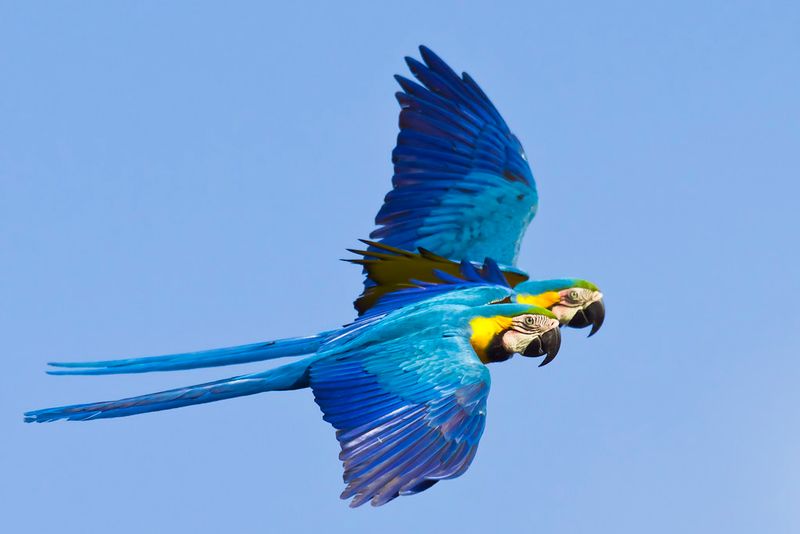
Jaw-dropping doesn’t begin to describe the sight of these magnificent birds soaring over California neighborhoods! I nearly drove off the road the first time I spotted a pair of these rainbow giants gliding between palm trees in Beverly Hills – definitely not your average traffic distraction!
These spectacular macaws combine vibrant cobalt-blue upperparts with golden-yellow underparts and a white facial patch with black stripes. With wingspans reaching over three feet, they’re impossible to miss.
Though less common than smaller parrot species, occasional escapees have established small, localized populations in affluent areas. Their booming calls can be heard from surprising distances as they feast on large nuts and fruits in California’s urban canopy.
12. Military Macaw (Ara militaris)
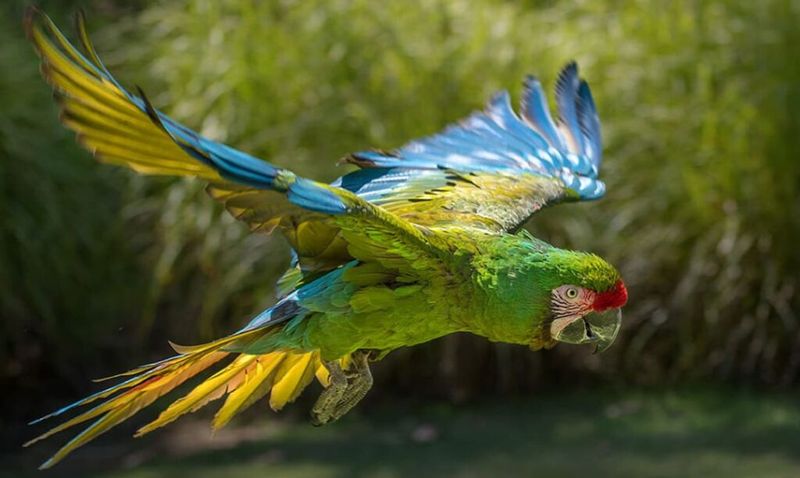
Commanding attention with their impressive size and olive-green plumage, Military Macaws bring a touch of rainforest majesty to California skies. My morning coffee routine got a serious upgrade when I spotted a pair of these magnificent birds exploring a fig tree outside my San Diego apartment!
These large macaws showcase primarily olive-green bodies with bright red foreheads and striking blue wing feathers. Their powerful beaks make quick work of even the toughest nuts and seeds.
Though less numerous than smaller parrot species, small groups of Military Macaws have established themselves in Southern California. Their loud, raucous calls echo through canyons and parks as they socialize in small flocks.
13. Monk Parakeet (Myiopsitta monachus)
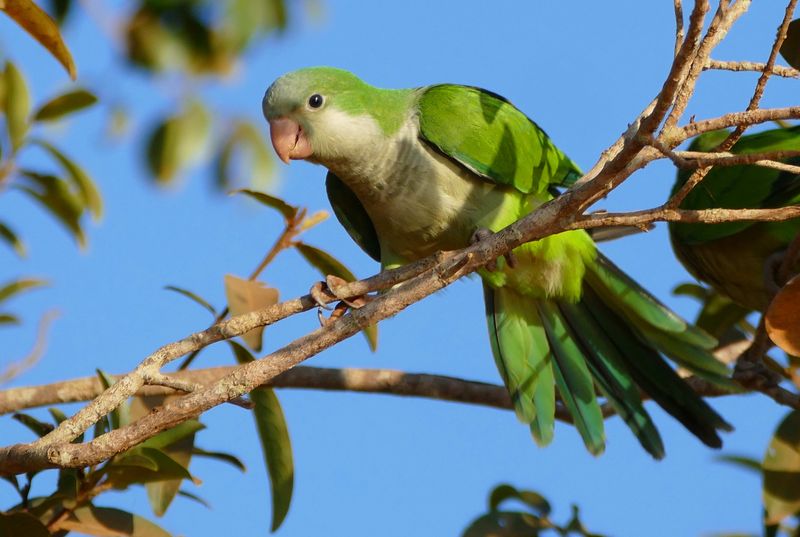
Architectural geniuses of the parrot world, Monk Parakeets bring both beauty and fascinating behavior to California neighborhoods. I was absolutely mesmerized watching a colony constructing their massive communal nest in a eucalyptus tree near Long Beach – nature’s condo developers at work!
These medium-sized parakeets feature bright green bodies with grayish foreheads and breasts, giving them a hooded appearance that inspired their monastic name. Unlike most parrots, they build elaborate stick nests that can house multiple families.
Originally from South America, these social birds have established small colonies in urban areas. Their constant chatter and busy building activities make them entertaining neighbors, though their large communal nests on utility poles sometimes cause controversy.
14. Canary-winged Parakeet (Brotogeris versicolurus)
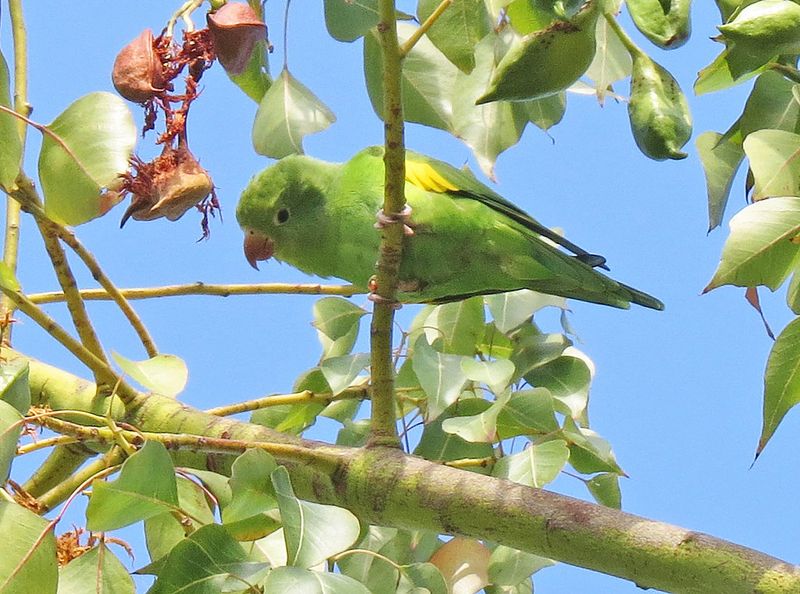
Flashy yellow wing patches make these petite parakeets look like they’re sporting designer accessories as they flit through California parks. During my weekend sketching session in a San Francisco garden, a small flock descended on a nearby flowering tree, turning it into a living, chirping ornament!
These small, energetic parakeets combine bright green bodies with those distinctive yellow wing patches that become especially visible during flight. They’re incredibly agile, often hanging upside-down to reach seeds and nectar.
Native to South America, these social butterflies have established several colonies in coastal California cities. Their high-pitched, musical calls create a tropical soundtrack in urban parks as they forage in small, tight-knit groups.
15. Yellow-collared Macaw (Primolius auricollis)
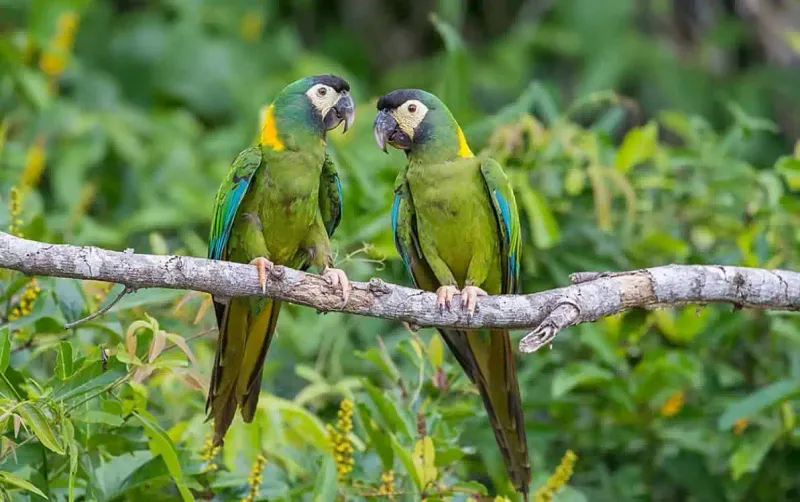
Sporting a fashionable yellow necklace against emerald plumage, Yellow-collared Macaws bring tropical elegance to California’s urban forest. I nearly dropped my binoculars in excitement when I spotted my first one perched regally on a palm frond in Pasadena, sunlight highlighting its golden collar!
These medium-sized macaws combine primarily green bodies with that distinctive yellow collar, blue wing tips, and red patches on their tails. They’re smaller than their more famous macaw cousins but no less charismatic.
Though relatively rare in California, small numbers have established themselves in the Los Angeles area. Their playful nature and acrobatic flying skills make them fascinating to observe as they forage for seeds, nuts, and fruits.
